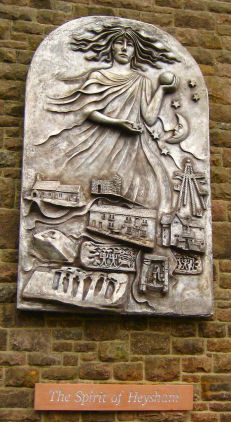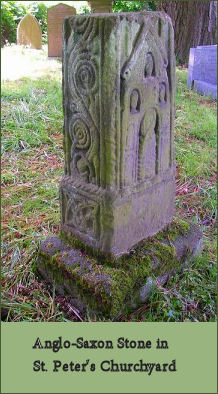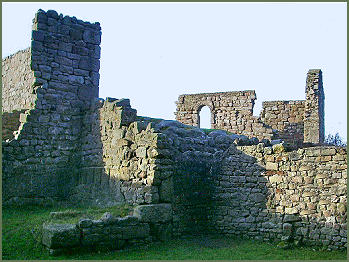Heysham
OS Grid ref:- SD415615

 The large Lancashire coastal village of Heysham overlooks the broad expanse of Morecambe Bay.
The large Lancashire coastal village of Heysham overlooks the broad expanse of Morecambe Bay.
The village has many characterful seventeenth century cottages and its vibrant floral displays have won Britain in Bloom’s Gold Small Village Award on two occasions. Heysham, with its spectacular Lake District backdrop was painted by the famous landscape artist, JMW Turner in the 1790s.
There is evidence of human settlement in Heysham and its surrounding area dating back as far as the Stone Age. Many tools and pottery artefacts have been found at the Barrows, an area of cliffs which is thought to be an ancient burial ground.
The Heysham Heritage Centre, situated on Main Street, is housed in a seventeenth century long house (cottage and barn) and houses objects relating to Heysham's fascinating history.
The ruined St Patrick's Chapel (pictured below right) perches dramatically on a headland above St Peter's Church. The atmospheric ruins overlook Morecambe Bay, with views of the southern Lake District beyond. They date back to eighth or ninth century, it is believed that the chapel was built to serve a monastic community. Most of the south wall, the east gable wall, and the east part of the north wall are still extant.
 The south wall contains a doorway with long and short jambs and an arch with concentric grooves. The remains vary in height from foundation level to around 12 feet high. The chapel is an undivided rectangular building, like a Celtic Oratory, of the tenth century, except that it has a round Saxon arch to the doorway.
Just to the south of the chapel is a group of six rock-cut tombs and a separate group of two rock-cut tombs, each tomb has an associated socket probably intended for a timber cross.The slabs which covered the graves and the contents, were removed long ago.
The south wall contains a doorway with long and short jambs and an arch with concentric grooves. The remains vary in height from foundation level to around 12 feet high. The chapel is an undivided rectangular building, like a Celtic Oratory, of the tenth century, except that it has a round Saxon arch to the doorway.
Just to the south of the chapel is a group of six rock-cut tombs and a separate group of two rock-cut tombs, each tomb has an associated socket probably intended for a timber cross.The slabs which covered the graves and the contents, were removed long ago.
The small village Church of St. Peter's occupies the site of a former church which is believed to have been founded in the seventh or eighth century. In 1080 it was recorded that the location was the site of an old Saxon church. Some of the fabric of the former Saxon church is visible in the present building. The chancel dates from around 1340–50 and the south aisle was added in the fifteenth century.
The north aisle was added to the building in 1864 and further extensions and restorations were carried out by the Lancaster architect E. G. Paley. At that time an Anglo-Saxon doorway was moved and rebuilt in the churchyard, and two galleries which had served as private pews with their own entrances were taken down. On the west wall a medieval sepulchral slab with a floriated cross and sword can be seen.
 The grounds of St. Peter's Church contain several Saxon and Viking remains, while the church itself contains a Viking hogback stone. The purpose of these stone sculptures is the subject of much debate, they are found mainly in the north of England, and also in Scotland, Wales, Ireland, and a few areas of southern England with Viking links.
The grounds of St. Peter's Church contain several Saxon and Viking remains, while the church itself contains a Viking hogback stone. The purpose of these stone sculptures is the subject of much debate, they are found mainly in the north of England, and also in Scotland, Wales, Ireland, and a few areas of southern England with Viking links.
A pre- Roman labyrinth carving was discovered on the foreshore at Heysham in 1995 by Clive Dainty, a photographer and journalist, Heysham is one of only three sites in Britain and Ireland that contain such a labyrinth carving, the others being located at Tintagel, Cornwall and Hollywood, Co. Wicklow, Ireland.
Heysham Harbour was built in 1900, and operates a ferry service to the Isle of Man, as well as freight to Ireland and services for the eastern Irish Sea
Heysham Moss Nature Reserve consists of a variety of habitats including areas of woodland and scrub, wet grassland and most importantly the central area of raised bog.The reserve is of ornithological interest for both breeding and wintering birds. Breeding birds have included Lapwing, Shelduck, Grasshopper Warbler, Reedbunting, Skylark, Linnet and Grey Partridge. Wintering birds include Snipe, Jack Snipe, Woodcock and Teal as well as flocks of Redwing and Fieldfare.
Nearby places of interest
Lancaster-the county town of Lancashire.
Morecambe large coastal resort on Morecambe Bay.
Crook O' Lune popular beauty spot on the River Lune, 4 miles from Lancaster
Whalley Abbey- founded by Henry de Lacy, third Earl of Lincoln on the 4th April 1296.
